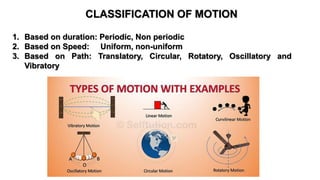1. Rotational motion refers to the movement of an object around an axis or center point, with each particle moving in a circular path around the axis of rotation.
2. The key difference between circular and rotational motion is that in rotational motion, the object rotates around a fixed axis, while in circular motion the object simply moves in a circle without rotation around an axis.
3. Moment of inertia quantifies an object's resistance to changes in its rotational motion, playing a similar role for rotational motion as mass does for translational motion. It depends on the object's mass distribution and distance from the axis of rotation.



































![Torque τ is defined as a quantity in rotational motion,
which when multiplied by a small angular
displacement gives us work done in rotational
motion. This quantity corresponds to force in linear
motion, which when multiplied by a small linear
displacement gives us work done in linear motion.
PHYSICAL SIGNIFICANCE OF TORQUE:
Torque in rotational motion is same as force
in linear motion! All it does is include the
angular rotation. Otherwise torque is the
force that would cause displacement.
Torque is the turning effect of a force about
the axis of rotation.
τ = r x F = rF sinθ n
It is a vector quantity. If the nature of the
force is to rotate the object clockwise, then
torque is called negative and if rotate the
object anticlockwise, then it is called
positive.
Its SI unit is ‘newton-metre’ and its
dimension is [ML2T-2].
In rotational motion, torque, τ = Iα where a
is angular acceleration and 1is moment of
inertia.
• Torque is the twisting effect of the
force applied to a rotating object
which is at a position r from its
axis of rotation. Mathematically,
this relationship is represented as
follows:
TORQUE τ](https://image.slidesharecdn.com/rotationalmotionblcswefall23-231117180015-62140b08/85/ROTATIONAL-MOTION_BLC_SWE_FALL23-pptx-36-320.jpg)













